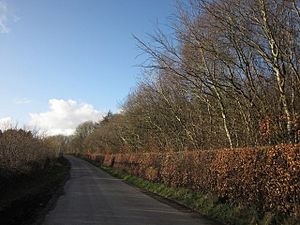Briggins Moor facts for kids
| Site of Special Scientific Interest | |
 |
|
| Area of Search | Somerset |
|---|---|
| Coordinates | 51°00′49″N 3°34′46″W / 51.01369°N 3.57944°W |
| Interest | Biological |
| Area | 37.8 hectares (0.378 km2; 0.146 sq mi) |
| Notification | 1994 |
Briggins Moor is a very special natural area in Somerset, England. It's a type of wetland called a "moor" or "mire." This wild and untouched marshy area is so important for nature that it has been protected since 1994. It covers about 15.3 hectares, which is a large space for plants and animals to thrive. You can find Briggins Moor south of Dulverton, close to the border with Devon.
Contents
What is Briggins Moor?
Briggins Moor is a unique kind of wetland. It's known as an "unimproved mire." This means it's a natural marshy area that hasn't been changed much by people. It's different from farmland or areas that have been drained. These types of wild wetlands are quite rare now, especially in places like south-west England and Wales.
Why is Briggins Moor Special?
Briggins Moor is a Site of Special Scientific Interest (SSSI). This is a special title given to places in the UK that are important for their plants, animals, or geology. The government protects these sites to make sure their unique nature is kept safe for the future. Briggins Moor was given this protection in 1994 because of its rare wetland habitat and the wildlife it supports.
Plants of the Moor
Many interesting plants grow in the wet conditions of Briggins Moor. Two plants you'll see a lot are purple moor-grass (Molinia caerulea) and meadow thistle (Cirsium dissectum). Purple moor-grass is a tall, tufty grass that loves damp soil. Meadow thistle has pretty purple flowers and is a favourite for insects. These plants help make the moor a perfect home for other creatures.
Animals of the Moor
Briggins Moor is also home to some amazing animals. One of the most famous residents is the marsh fritillary butterfly (Eurodryas aurinia). This beautiful butterfly is quite rare in the UK, but Briggins Moor has a large group of them. The marsh fritillary needs specific plants, like the meadow thistle, to lay its eggs and for its caterpillars to eat. Protecting places like Briggins Moor helps these special butterflies survive.

